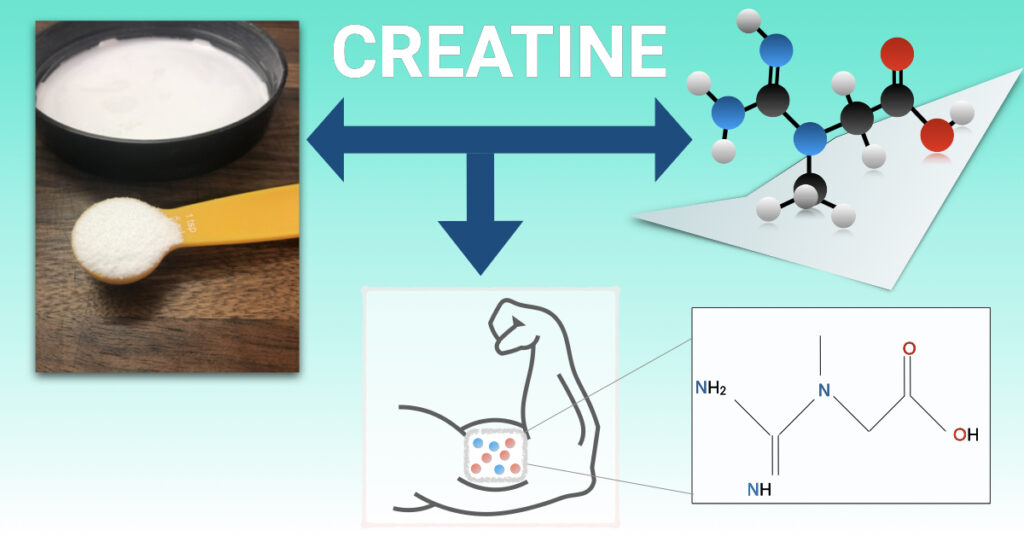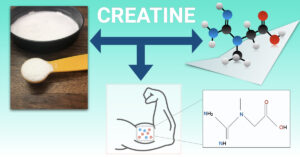I’ll be honest. When I first started working out at the age of 18, I thought creatine was a steroid or something akin to one. I thought it would damage my kidneys and that I would develop acne. I thought it would bloat my stomach and cause me a host of gastrointestinal issues. Heck, I thought it would cause several types of irreversible damage. What’s the problem here? Well, first, creatine does none of that. Second, I simply did not have adequate knowledge. And therein lies the problem. I didn’t have adequate knowledge. In this article, I’ll be discussing what creatine is, whether you should take it and how it should be taken.
In truth, creatine is one of those supplements that’s worth the cost…in some cases. It’s well-researched. In fact, it’s backed by decades worth of research with over 1000 studies since the 90’s. It’s cheap. It’s not complicated. And for most people, it works. You’ll find that the supplement industry only continues to expand with new, more complicated and hard-to-pronounce products. But if you ask anyone on a fitness forum or in the gym, you’ll probably hear that creatine monohydrate is amongst their top supplement. So let’s start off with what it is.
What Is Creatine?
Creatine is an organic molecule found in the body, made from three amino acids: Methionine, Glycine and Arginine. It is synthesized mainly in the liver and kidneys but 95% of it is stored in skeletal muscle. Beyond supplementation, creatine is also found in high protein foods, such as red meat or seafood. However, to obtain a useful amount of creatine from foods usually requires ingesting an impractical amount at once. It is important to note that creatine exists in equilibrium with creatine phosphate (PCr) in a 1/3 : 2/3 ratio, respectively. Since the body is capable of creating its own storage of creatine, it is not considered an essential nutrient.
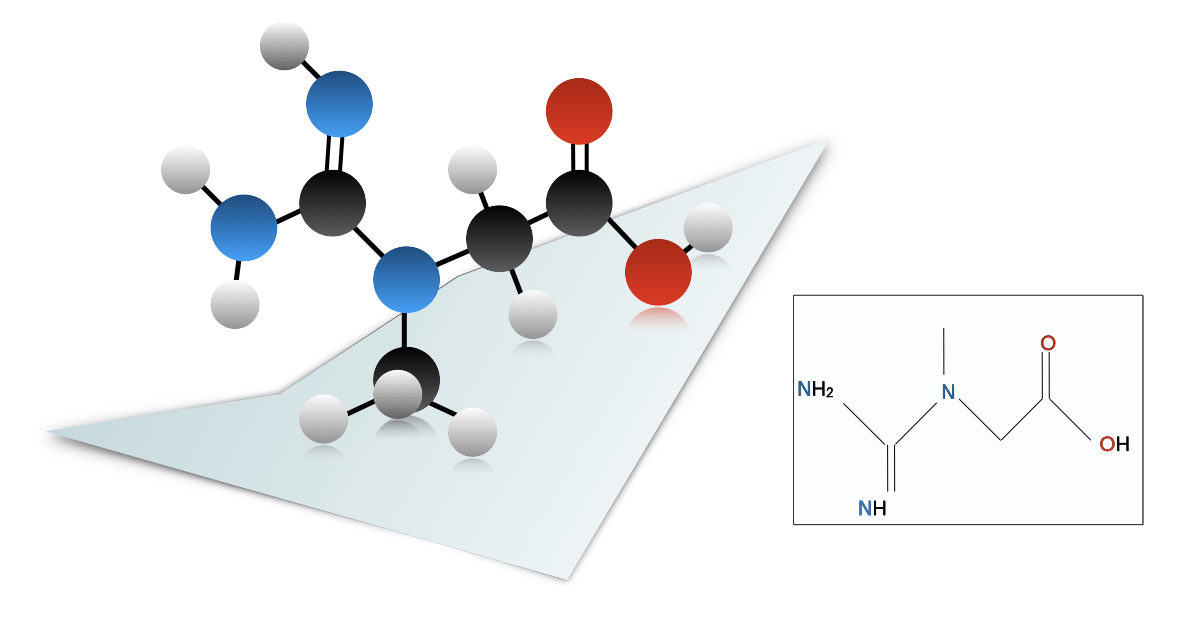
If it is not considered an “essential nutrient,” why is it one of the go-to supplements of fitness enthusiasts? Well to answer that, we need to understand that in order for the body to function and produce movement, it requires chemical energy in the form of ATP (Adenosine Triphosphate). You may have heard of this because the energy released from this molecule is essentially the “currency” the body must pay for movement. When you perform a bench press, get up and walk, or contract your muscles, ATP comes into play. But ATP is not present in large quantities within muscle cells. In fact, there is enough energy produced for about 5 seconds, which means for sustained movements and contractions, there needs to be more ATP manufactured.
There are several energy systems in the body that will produce ATP but the one we’re concerned with for workout performance is through creatine phosphate (Phosphagen system). Essentially, when ATP has been consumed, creatine phosphate is broken down by the enzyme Creatine Kinase to yield creatine and a phosphate group. This phosphate group, in turn, regenerates ATP from ADP (Adenosine Diphosphate) and allows you to finish that last rep or take you the finish line on that sprint.
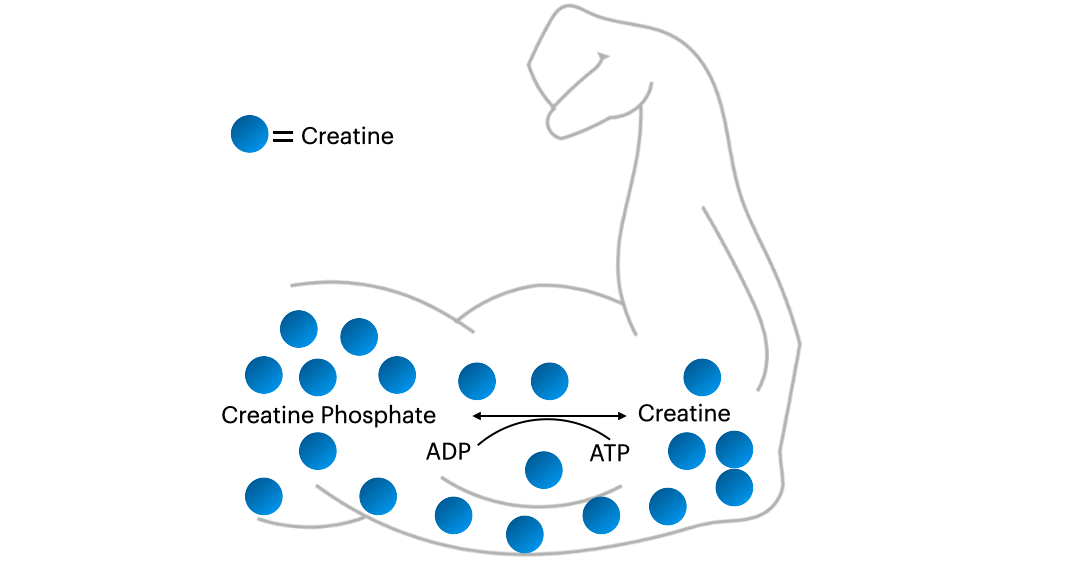
How Does Creatine Supplementation Work?
Remember how we learned that the body produces and stores about 95% of creatine in the muscle? Well, the idea behind supplementing with creatine simply means increasing your creatine storage. Research noted that when excess creatine was consumed, it was not expelled from the body. This suggested that the body stores creatine when possible and so its use as a supplement was viable. With more creatine in the body, you have a greater rate of replenished ATP for those 2-3 reps you couldn’t accomplish. Although 2-3 reps may not seem like much at first, they’ll contribute a lot in the grand scheme of things. Let’s say you finally worked your way up to benching 225 lbs for one rep. Imagine being able to stack 1 or 2 more reps.
Who Should Take Creatine?
Now that we’ve established the primary function of creatine as a reserve for energy, who exactly should supplement? Well first of all, research has indicated that most individuals stand to benefit from creatine muscle saturation. This is when the resting amount of creatine in our bodies increase through supplementation. However, some individuals naturally have a higher concentration of creatine in their muscles. Because of this, supplementation adds very little change and these individuals are generally termed non-responders.
To determine if you are a responder or not, you’ll simply need to experiment with creatine. Typically, you should see an increase in weight (if all other things are kept consistent. i.e. caloric intake). This increase would be due to water retention. Additionally, an increase in 1-RM should be noticeable after taking creatine for at least 4 weeks.
Another factor to consider is the type of activity you engage in. For instance, creatine is good at producing ATP for around 8-10 seconds after initial muscle ATP is used up. This would mean individuals who engage in high-intensity workouts, weightlifting or some other activity that requires power would benefit. Essentially, creatine is effective for people who engage in anaerobic workouts instead of aerobic workouts. This is because aerobic workouts generate ATP through a different system termed Cellular Respiration in the presence of oxygen. If you’re wondering what aerobic workouts are, think: long-distance running, cross country or some other low-intensity steady-state activity (LISS). These types of activities require a different energy source to produce sustained amounts of ATP.
How To Take Creatine
There are two ways to take creatine: the loading phase and the regular phase. I’ll talk about the loading phase first because I don’t advise taking it in this manner. But there are pros and cons to everything, so we’ll go over that.
Loading Phase
The loading phase is termed as such because you are trying to saturate your muscles with as much creatine as quickly as possible. The literature suggests taking 0.3g per kilogram of body weight per day for 5-7 days. For instance, I currently weigh 180 pounds or 81 kg. If I took the route of loading, I would take a total of 25g per day (spaced evenly throughout the day) for 5-7 days. After that, I would take 0.06g per kilogram of body weight every day for 4-5 months or however long I’d like to be on it. This would equate to about 5g per day afterward.
Although this method will certainly saturate your muscles as quickly as possible, I find it unnecessary. This is because taking the normal route will eventually lead to the same creatine storage if you are a responder. It simply would take a little longer. However, since regular creatine monohydrate is incredibly cheap, the savings in money used in the regular phase is probably negligible.
There are some people who believe that the loading phase could be detrimental to kidney function but a 2019 study indicated no renal damage. The study included individuals who took varying doses of creatine ranging from 4g/day to 20/day but exhibited no signs of kidney damage when compared to a placebo group.
Some individuals have reported excessive bloating or digestive discomfort when loading with creatine. This is another reason I would advise against the loading phase.
Normal Phase
In the normal phase, you would simply consume 0.03-0.06g per kilogram of body weight per day. There is no upper limit of when you could stop taking it. Research has indicated that long term use of up to 5 years is safe.
This is the phase I choose to take with creatine. Typically, this route would require about 20 days before the muscles are completely saturated with creatine. This means that to see any noticeable improvements in your activity would require time.
Using myself as an example again, I would take 0.06g per kilogram of body weight every day for however long I’d like to be on it. This would equate to about 5g per day.
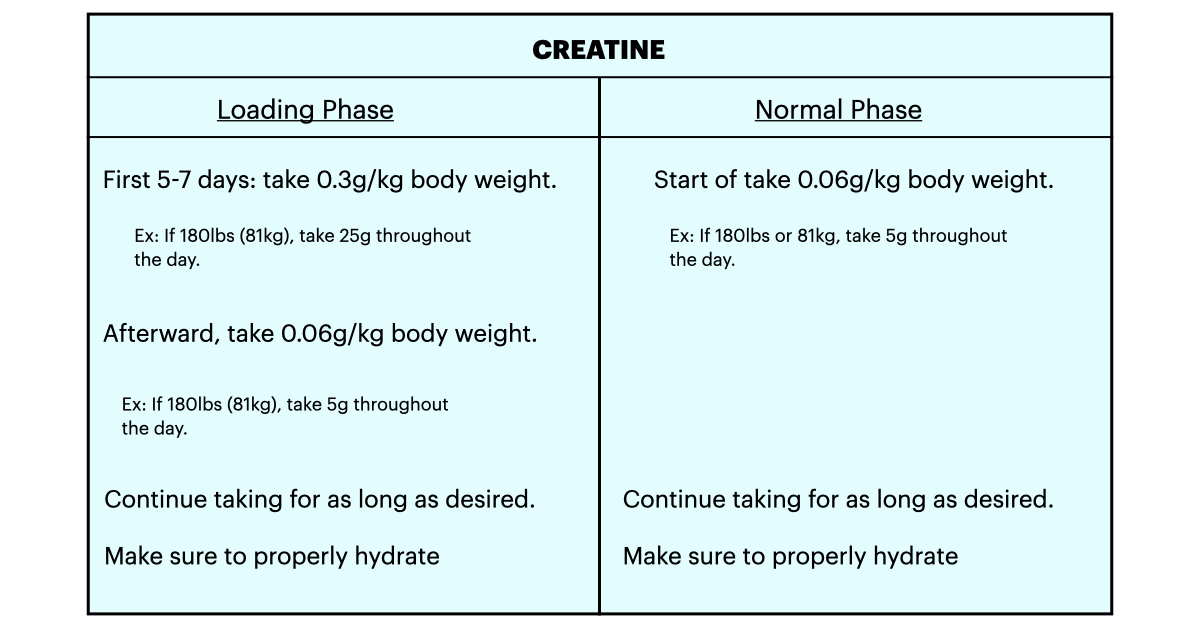
When To Take Creatine
As we’ve learned, creatine is not something that produces results overnight, regardless of the method you choose to take. However, research has concluded that there appears to be an optimal time in your day to consume it if you engage in exercise. A study done by Antonio & Ciccone concluded that creatine taken post-workout is superior to creatine taken pre-workout in relation to body composition and strength.
Part of this is possibly attributed to the fact that most people try to consume food or protein immediately after a workout. The idea is that a post-workout meal consisting of carbs, proteins and fats will naturally lead to elevated insulin levels in the body. Although insulin typically garners a bad rep, its function is to shuttle nutrients throughout the body. This would include creatine.
What Should I Take With Creatine?
Speaking of food, what exactly should creatine be taken with? Well, creatine itself doesn’t have much of a taste and you’ll likely take it dissolved in water, juice or a protein shake. But as mentioned above, its absorption will be best with a meal rather than on an empty stomach.
Specifically, it would be best to take with carbohydrates. The reason being “that the stimulatory effect of carbohydrates on muscle creatine accumulation is due to insulin-enhancing muscle creatine uptake […] mediated by carbohydrate intake” Essentially, this means that insulin can increase creatine accumulation in skeletal muscle tissue and that large amounts of simple carbohydrates could illicit this insulin-mediated response. However, the amount of carbohydrates required would estimate about 100g. This can be a substantial amount and perhaps even an impractical one depending on the user’s diet.
However, the same research also determined that the same insulin-mediated response could be achieved through a 1:1 ratio of 50g carbs and 50g protein. This is a much more balanced and efficient way of consuming a meal post-workout and with creatine.
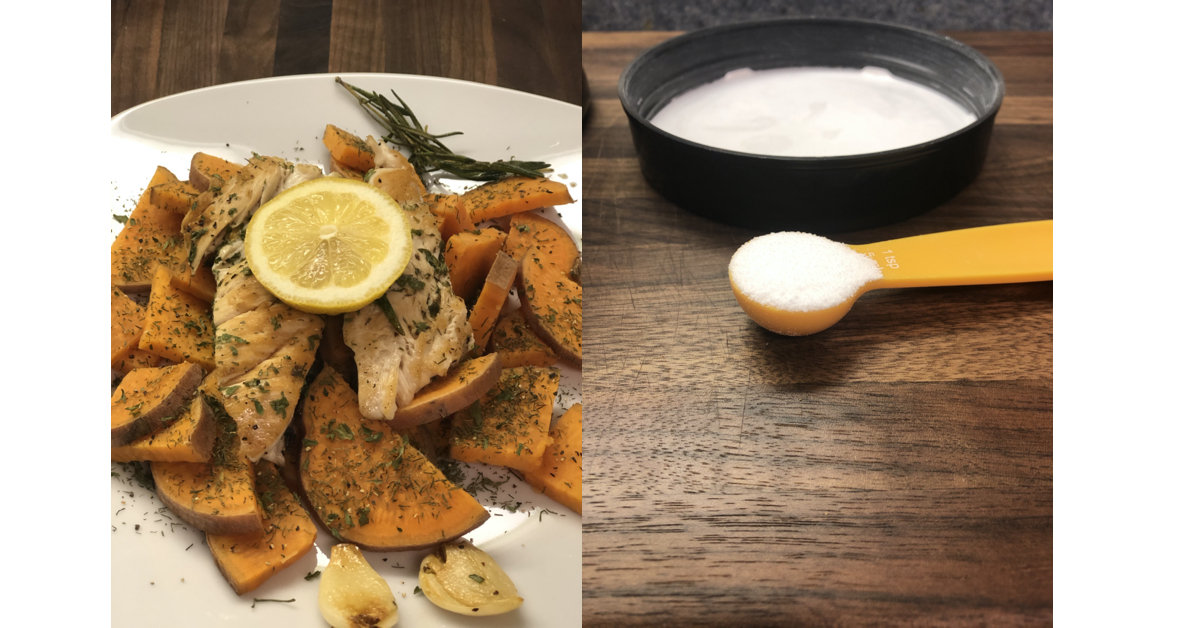
What Creatine Should I Take?
Ok, so I’ve convinced you to take creatine. Now what? Which one should you take? Because if you google “creatine supplement,” you’re bound to be bombarded by endless companies claiming to have the best creatine formula designed for your body.
Well, as I explained above, creatine is just an organic, nitrogenous compound and nothing more. You can quite literally see its chemical structure above. Because of this, I advise taking Creatine Monohydrate. I don’t care which brand or company you get it from because as long as its creatine monohydrate and it’s a reputable company, it’s good. You can’t really screw up creatine.
In fact, you might want to stay away from the other marketed forms of creatine as they are likely costlier and have less research backed into them than creatine monohydrate. If you do choose to read a research paper on another form of creatine, make sure you are aware of who is funding the study. For instance, if the company pushing a certain product is also funding its research…that could be a concern for internal bias.
Health Or Side-Effects
Although creatine has been the subject of research for decades, it is not without concern by individuals seeking to supplement with it. The most persisting side effect of creatine was weight gain due to intramuscular water retention. However, concern has been raised by users regarding stomach discomfort and a study that appeared to correlate the use of creatine with hair loss.
Weight Gain Due To Water Retention
First of all, water retention would actually be one way of determining if a user is a responder or non-responder to creatine. This is because creatine draws in water intramuscularly into the cells for use with ATP. If your storage of creatine in your muscle increases, water retention does as well. However, it should be addressed that some individuals reported cramping, lower leg pain and stomach discomfort. Likely, this is explained from inadequate hydration, leading to cramps. On an anecdotal note, I have only ever experienced stomach discomfort once when on a loading phase of creatine. This is another reason I prefer going the normal phase route.
I’d like to mention that weight gain due to water retention is not a bad thing. Most people who simply want to lose fat or lose weight are simply relying on the number they see on the scale. But if that weight increase is simply due to water retention, then your goal should be to lower your caloric intake, not water. It is important to stay properly hydrated by all means.
The only time I would actually worry about weight increase due solely to water retention is if I compete in a sport that requires a specific weight or range of weight, such as wrestling or boxing. In that case, I would try and cycle off of creatine 4-6 weeks before my check-in weight.
For those who are afraid that water retention means an increase in “puffiness” or a “bloated” appearance, then understand that creatine draws water into the muscle’s cells. This is not something you can simply observe from the outside. Water is not being stored subcutaneously, such as fat.
Hair Loss Concerns
Ok, if you’re a guy, then you probably scrolled straight to this section first. Despite all its benefits, perhaps the biggest reason some individuals avoid using creatine is the fear of hair loss. Where exactly did this fear come from? In a lone study back in 2009, it was demonstrated that within a 3-week period of time, using creatine increased dihydrotestosterone (DHT) in 20 college-aged, male rugby players. For those not familiar, DHT is an active biological androgen that can accelerates hair loss in men who have a history of male pattern baldness in the family.
However, this study did not provide a conclusive answer and indicated that the “relation between creatine and DHT are not completely understood.” The research further indicated that the high-frequency use of creatine among the population required further studies. I agree because 20 test subjects do not seem like an adequate number if a diverse population is supplementing with creatine. Additionally, this study has yet to be replicated or carried out with a more diverse population.
With that said, it’s important to note that if you are genetically disposed to hair loss, creatine is not something that will hurt or help. It simply might accelerate the process. Again, there is no conclusive research that correlates the use of creatine with hair loss in a scientifically acceptable manner. If hair loss is a concern, you might want to look into hair loss treatments and consult a doctor instead.
In my opinion, if you do not have a history of male pattern baldness, then I would encourage adding creatine to the top of your supplement list. It might just be the one and only thing you need. If you do have a history of male pattern baldness or you believe you are genetically disposed, you should consult a doctor for more professional advice.
Summary
- Creatine is a simple nitrogenous, organic compound made from Methionine, Glycine and Arginine.
- It aids in the regeneration of ATP, which is the molecule that converts chemical energy into useful work and movement.
- Creatine can be taken during a loading phase, where you ingest 25g of it per day for 5-7 days. Subsequent supplementation would then be 5g for however long you’d like to be on it. Alternatively, you can take the normal route which is simply consuming 5g per day for however long you’d like to be on it.
- It is best to take creatine with meal consisting of carbs and protein to ensure an increase in insulin.
- Taking creatine post-workout has show marginal but noticeable benefits over taking it pre-workout. Although, it must be understood that creatine takes time to be saturated in skeletal muscle.
- Creatine has been studied to be safe for consumption of up to 5 years. It has been concluded that creatine has no known negative effects on the kidneys. Other negative effects have yet to be confirmed although some evidence does suggest stomach discomfort and cramping with low hydration.
Conclusion
Although I hope this article cleared up a lot of misinformation about creatine, it’s important to understand that it is just a supplement. Your goal for a healthy and functionally efficient body will rely on the work and nutrition you cater toward your body rather than something you buy at a store. Creatine will undoubtedly help you make greater strength gains or increase your muscle mass. But none of that means anything without making sure the center of your attention is a proper workout regimen and nutrition.
If you enjoyed this article, feel free to also follow me on Instagram. In the future, I also hope to create a video for this article so stay tuned, subscribe for more articles and take care!
References
- Cooper R, Naclerio F, Allgrove J, Jimenez A. Creatine supplementation with specific view to exercise/sports performance: an update. J Int Soc Sports Nutr. 2012;9(1):33. Published 2012 Jul 20. doi:10.1186/1550-2783-9-33
- Steenge GR, Simpson EJ, Greenhaff PL. Protein- and carbohydrate-induced augmentation of whole body creatine retention in humans. J Appl Physiol (1985). 2000;89(3):1165‐1171. doi:10.1152/jappl.2000.89.3.1165
- Buford TW, Kreider RB, Stout JR, et al. International Society of Sports Nutrition position stand: creatine supplementation and exercise. J Int Soc Sports Nutr. 2007;4:6. Published 2007 Aug 30. doi:10.1186/1550-2783-4-6
- Kreider RB, Melton C, Rasmussen CJ, et al. Long-term creatine supplementation does not significantly affect clinical markers of health in athletes. Mol Cell Biochem. 2003;244(1-2):95‐104.
- Antonio, J., Ciccone, V. The effects of pre versus post workout supplementation of creatine monohydrate on body composition and strength. J Int Soc Sports Nutr 10, 36 (2013). https://doi.org/10.1186/1550-2783-10-36
- Cancela P, Ohanian C, Cuitiño E, Hackney AC (September 2008). “Creatine supplementation does not affect clinical health markers in football players”. British Journal of Sports Medicine. 42 (9): 731–5.
- Buford TW, Kreider RB, Stout JR, et al. International Society of Sports Nutrition position stand: Creatine supplementation and exercise [published online ahead of print August 30, 2007]. J Int Soc Sports Nutr. 2007;4:6.
- Kraemer, William J. Exercise Physiology Integrating Theory and application
- Lopez RM, Casa DJ, McDermott BP, Ganio MS, Armstrong LE, Maresh CM. Does creatine supplementation hinder exercise heat tolerance or hydration status? A systematic review with meta-analyses. J Athl Train. 2009;44(2):215‐223. doi:10.4085/1062-6050-44.2.215
- van der Merwe J, Brooks NE, Myburgh KH. Three weeks of creatine monohydrate supplementation affects dihydrotestosterone to testosterone ratio in college-aged rugby players. Clin J Sport Med. 2009;19(5):399‐404. doi:10.1097/JSM.0b013e3181b8b52f

